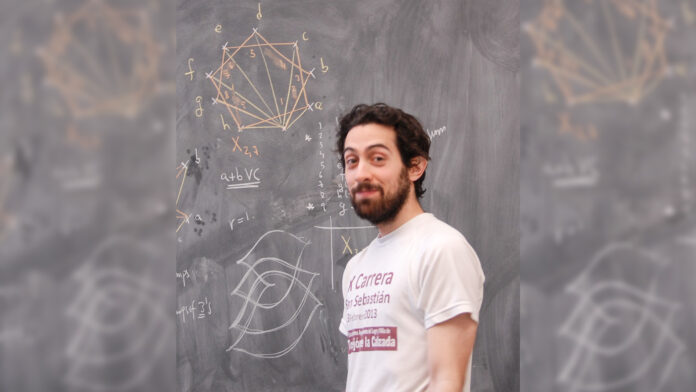Geometry professor funded for further studies in Lagrangian fillings of Legendrian knots
In the span of one month, Roger Casals Gutierrez, an assistant professor in the Department of Mathematics, won two prestigious awards: the 2020 Sloan Research Fellowship by the Alfred P. Sloan Foundation and a CAREER award from the National Science Foundation’s (NSF) Early Career Development Program. Out of the 20 Sloan Fellows named this year from UC campuses, Casals was the only professor from UC Davis.
Sloan Research Fellowships are awarded each year to 126 “outstanding young researchers in mathematics, chemistry, computer science, economics, computational and evolutionary molecular biology, neuroscience, ocean sciences or physics,” according to the UC Davis press release. Winners can spend their $75,000 earnings on any expense supportive of their research over a two-year period. The Sloan Research Fellowship website called these “early-career scholars” the “most promising scientific researchers working today” in the U.S. and Canada.
CAREER awards support junior faculty who “perform outstanding research, are excellent educators and integrate outreach in their work,” according to the press release. Winners of CAREER awards earn $450,000 over the next five years as funding for themselves and also for undergraduate and graduate research, Casals said.
Casals became a professor at UC Davis in July 2018. He earned his doctorate in geometry and topology, which is the study of geometric properties and spatial relations, from the Institute of Mathematical Sciences in Madrid, Spain. Prior to teaching at UC Davis, he worked at the Massachusetts Institute of Technology and the University College London.
“[Davis] has been really great,” Casals said. “I really like it.”
Motohico Mulase, a professor in the department of mathematics, interviewed Casals when he was being considered for hire. Mulase said Casals’ achievements were impressive and he liked his positive demeanor.
“[Casals’ hiring] is considered to be worthwhile and is far rewarded,” Mulase said. “He’s indeed changing the scope of UC Davis in the quality of research and happiness. As you see him, he is a happy person.”
Even at this early stage of Casals’ career, he has already been published in the top three mathematical journals: Journal of the American Mathematical Society, Inventiones Mathematicae and Princeton University’s Annals of Mathematics.
“[Casals’] publication record is kind of amazing, since he’s only a few years out of Ph.D.,” Mulase said. “Any professor would be happy to be published in one, but he’s in all three.”
Casals’ area of research is contact geometry, which involves the shapes created by rays of light as they bounce off objects, called caustics. Examples of caustics are the bright curved shape that appears in a coffee cup when light is reflected on it, the pattern of light bouncing off ocean waves or the path of a car reversing into a parking space. By connecting this work to other fields, Casals has made discoveries about caustics and developed new tools to describe them.
As a professor, Casals teaches classes, researches and performs duties for the math department, but his recent awards will now give him the funding to focus more on the research component of his work, which is the goal of the fellowship.
“The Sloan allows me to, for the next two years, tackle harder problems,” Casals said. “I’m going to be very ambitious and try these other projects because now I’ll have the time to invest.”
With this award, Casals can travel to conferences, meet with collaborators and work with students on research.
“Sometimes you’re trying to face a very hard problem, like a conjecture that’s been open for many years,” Casals said. “It’s required for you to work on it for like seven, eight hours a day for like a year, and if you have to teach a class, well that’s very important as well, but sometimes it does not really allow you to focus fully on that [research].”
Abigail Thompson, a math professor and the chair of the Mathematics Department, said via email that this award will give Casals a lot of extra time for his major projects.
“It’s a great boost at this early stage in his career,” Thompson said. “The Sloan award is an incredible honor — we’re very lucky to have been able to attract Roger to our department.”
One of the projects Casals wants to work on is studying Lagrangian fillings of Legendrian knots. Like flying string in space, these knots are the boundaries of surfaces. This research is important for studying energy level sets of the earth, moon and sun and where probes or satellites could be sent.
“[We] are going to learn the possible energy level sets and spaces in which these knots live and the surfaces [we] are trying to create are important in understanding the geometry,” Casals said.
Fifteen percent of Sloan Research Fellowship winners have been from UC campuses. Casals said he “felt pretty good” to be chosen as a winner, but also thinks that winning involved being “in the right place at the right time” in his career.
Despite his great achievements, Casals does not often talk about these accolades in class. Tonie Scroggins, a graduate student in the department of mathematics and student in Casals’ topology class, said Casals is very humble. Casals does, however, talk about his research and what he teaches in seminars.
“[Casals] is almost always working,” Scroggins said.
Casals has a great passion for mathematics and teaching, which clearly shows in his lectures, said Sienna Mengjia Yang, a fourth-year mathematics major currently in Casals’ euclidean geometry class, via email.
“Taking his class is like watching a great Shakespeare opera,” Yang said. “You get to watch a great performance and enjoy the beauty of math. It is always great to see how his mind works and approaches different problems.”
Casals makes himself very available to help students fully understand the material. Yang said he is caring, understanding and patient. Shanon Rubin, a graduate student in the department of mathematics and student in Casals’ topology class, said it is important that Casals makes himself so available for students since his classes are challenging and demanding.
“[Casals] expected a lot from the whole class,” Rubin said. “But, the harder he makes his class, the more he has to be in his office with the door open waiting for people to ask questions.”
Rubin also noted that while homework assignments can be time-consuming and hard, Casals accommodates.
“It’s not a complaint, it’s just a fact,” Rubin said. “He makes it work, though, and balances it. If we need more time on something or less problems on the next homework, he’ll give it to us. It’s really demanding but at least he’s surprisingly very available.”
Since Rubin is a TA for Casals’ euclidean geometry class, he spends a lot of one-on-one time with him. At their weekly meetings, Casals briefs Rubin on what he should teach in the section, but also likes to talk about the advanced classes Rubin takes. Casals likes to tie in topics from those classes to show how they all relate, Rubin said.
“[Casals] definitely brings in the big picture,” Rubin said.
Scroggins said she appreciates Casals’ enthusiasm for teaching and the jokes he makes in class. He recently compared toruses, which are donut-like shapes in geometry, to ice cream cones and joked about how many knots he has drawn in his work.
“He [teaches] with a smile,” Scroggins said. “He said that there hasn’t been a day in the last seven years that he hasn’t drawn a knot.”
Written by: Margo Rosenbaum — science@theaggie.org





